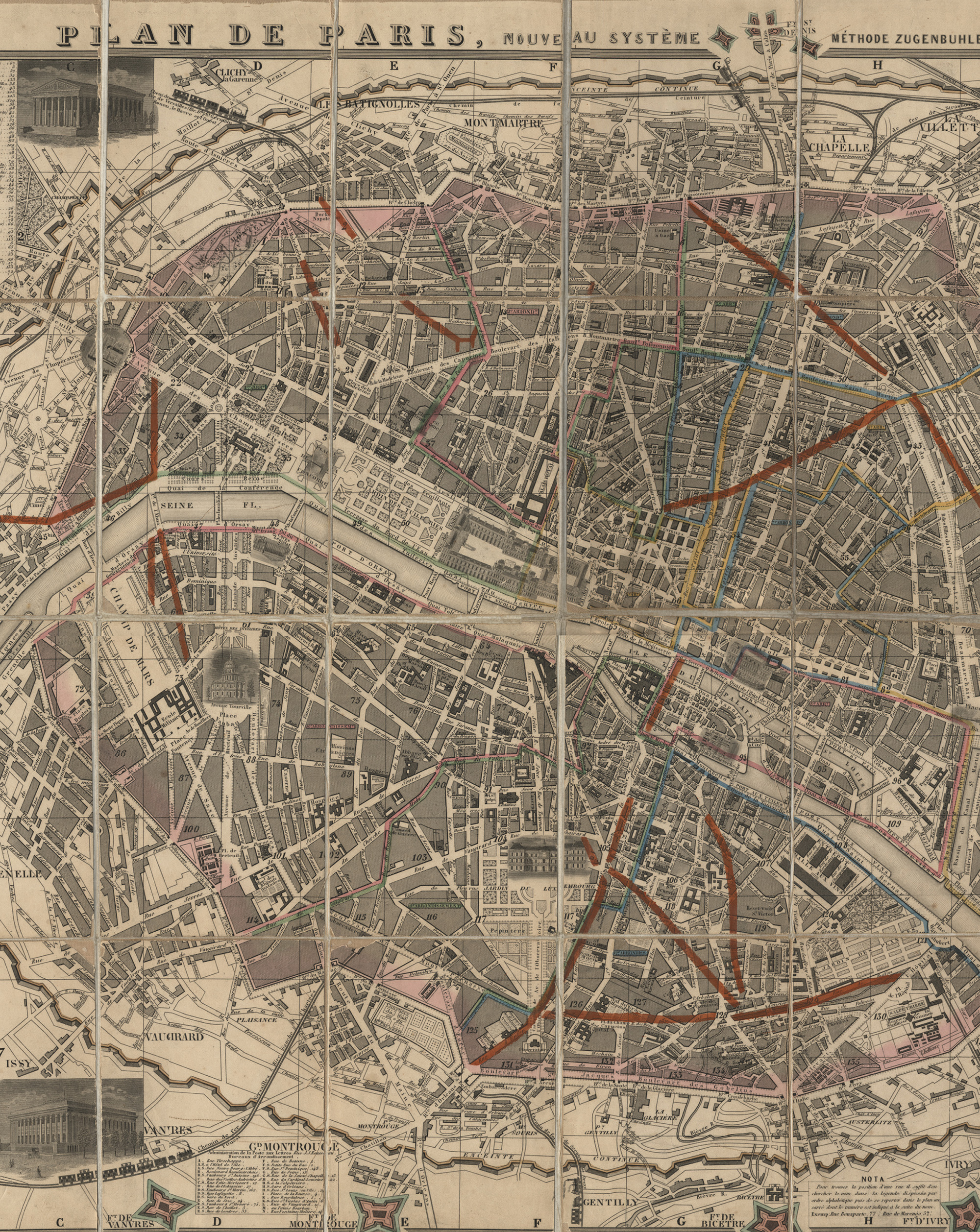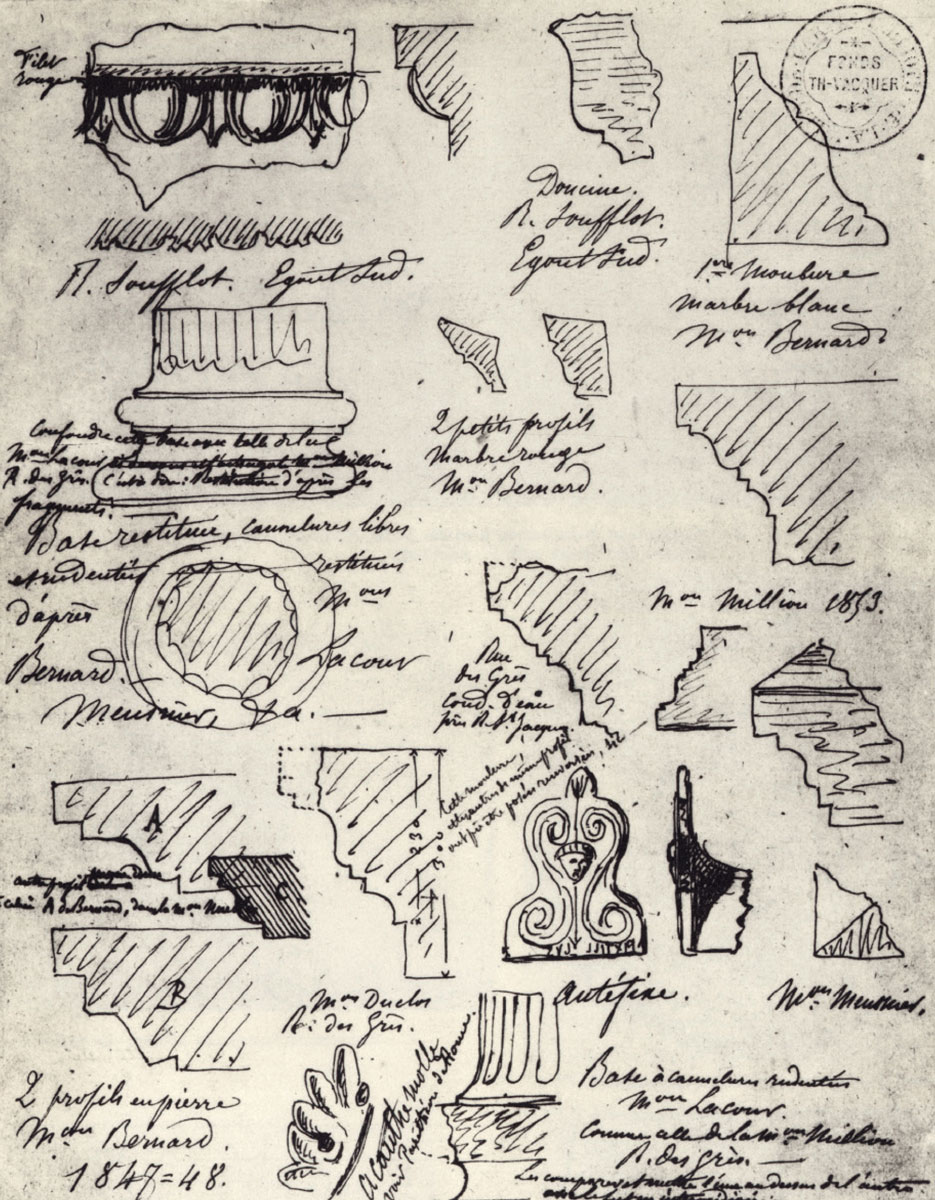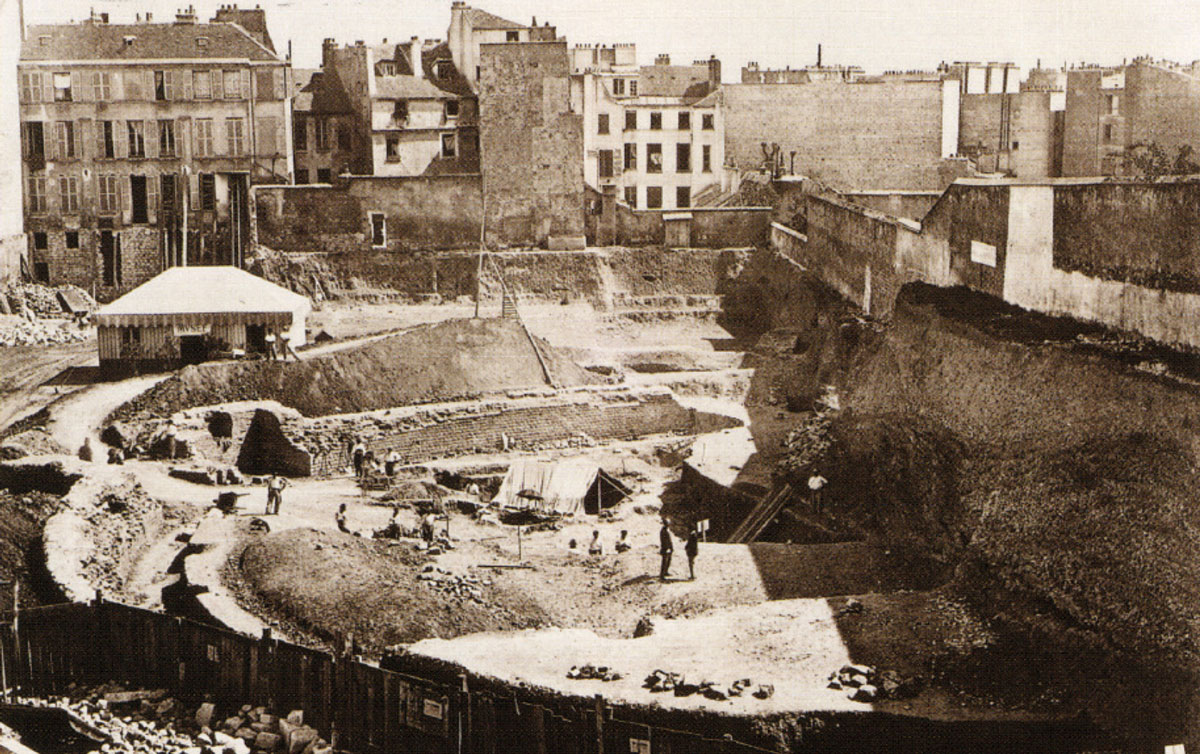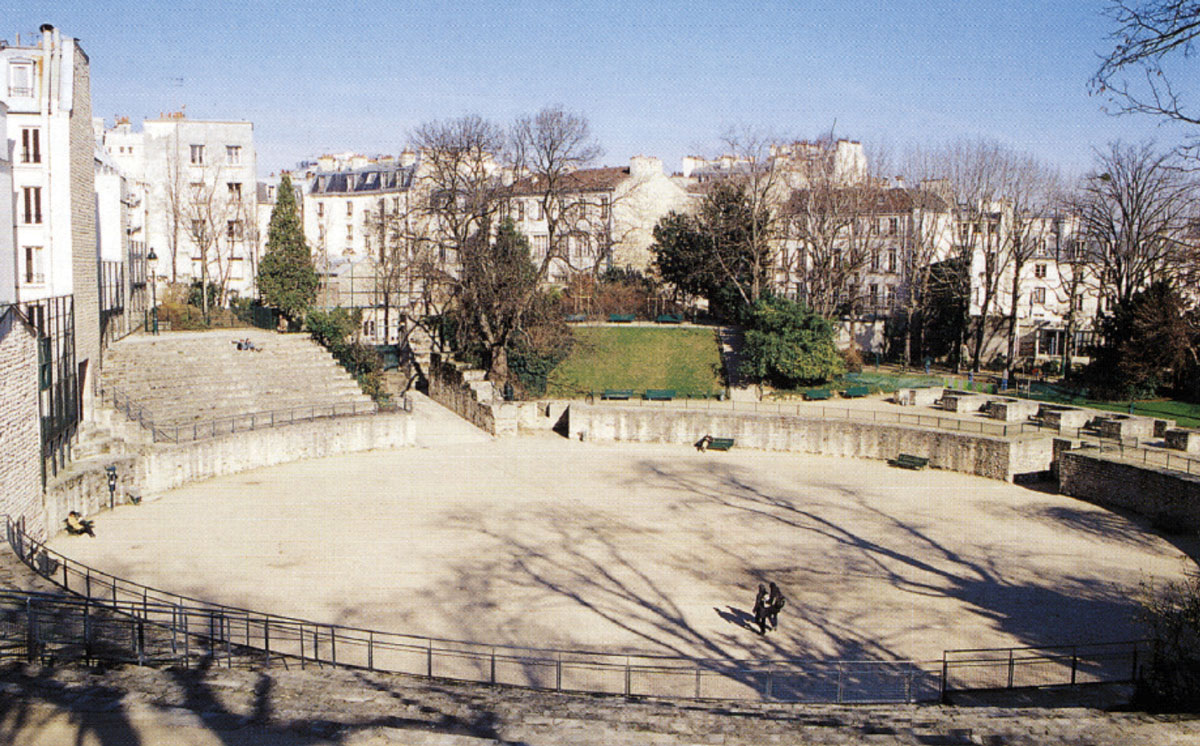The Archaeology of Modernity
Theodore Vacquer, Baron Haussmann’s doppelganger
Colin Jones

The life of Théodore Vacquer was lived under the star of anonymity, isolation, and failure. A failed engineer, a failed architect, a highly ambitious author who wrote copiously, if largely indecipherably, yet published next to nothing, Vacquer was an individual whose rebarbative character was such that even his friends referred to him as “a wild boar” and “a permanently rolled-up hedgehog.” His desperately unglamorous portrait reveals an oblique gaze half hidden from view by his spectacles, the demeanor of a funeral parlor director, and the rough, embarrassed hands of a workman, not an intellectual.
This exemplar of personal failure was an archaeologist employed by the City of Paris who spent all his life excavating, viewing, and reflecting upon the distant past of his native city. Born in 1824, he attended all (and directed many) substantial excavations in Paris between the 1840s and his death in 1899. His life and work thus overlapped with the period in which Paris was refashioned and mythologized as the city of modernity under the inspiration of Baron Haussmann, Emperor Napoleon III’s Prefect of the Seine from 1853 to 1870. In essence, Vacquer was Haussmann’s doppelgänger. For in order to refashion Paris as the city of modernity, Haussmann and his ilk had first to dig down beneath millennia of construction into soil at the historic heart of the city, uncovering a past almost totally unknown and largely unsuspected. Haussmann operated through the erasure of topological features and the material culture and vestigial traces of a discardable past: Vacquer made of those very processes of destruction and reconstruction the substance of his life and work.
As Haussmann created a new city out of the filthy, disease-ridden and crime-infested hellhole described in the novels of Balzac and Eugène Sue, Vacquer located a lost one, namely, Roman Lutetia. The Roman baths currently visible on the Boulevard Saint-Michel had long been known (though in fact they were invariably mistaken for the palace of the fourth-century AD Roman Emperor, Julian the Apostate, who had briefly resided in the city). Through extensive observation and excavation, Vacquer also identified for the first time the late Antique/early medieval rampart on the Île de la Cité, the Roman street plan, a theater on the Rue Racine, a forum and associated buildings on the Rue Soufflot, cemeteries out beyond the Luxembourg gardens and in the south-east of the city close to the Gobelins, and, nearby, an amphitheatre (the arènes de Lutèce). All this was literally terra incognita for more than a millennium-worth of Parisians.
One might have anticipated these discoveries chiming in well with the imperial, classical idiom that had long been a tradition in Parisian urban planning. Indeed, Haussmann’s reconstruction of the city—with its quasi-rectilinear street grid, its wide, triumphalist roadways, and its visually aligned power-monuments—drew heavily on this idiom. Yet Haussmann, like virtually all municipal and national officials, largely ignored the Roman remains that Vacquer uncovered. This refusal to respond positively to such an astonishing range of Lutetian finds may seem surprising. Yet if Parisians bathed in an aura of Romanitas, they preferred their city to be compared to Rome itself, not the provincial hick town that Lutetia had been. Vacquer’s ruins and finds were judged simply not grand enough to be worthy of preservation. They contributed nothing to the myth of modernity that Haussmann was busy constructing. In any case, the practice of conservation of heritage (patrimoine) was still relatively in its infancy at this time, and focused less on urban neighborhood sites than on major monuments. And these had been in short supply in Roman Lutetia. If there was grandeur to be found in Paris’s ancient past, it lay in the city’s medieval remains, not its Roman ruins. (Exactly the opposite was true of Rome itself, whose archaeology in the same period consisted in the callous discarding of the medieval strata so as to reach as the classical substructures that lay beneath.)
The failure of the discovered ruins of Lutetia to be incorporated into the Haussmannian mythologization of Paris is clearly evident as regards what was probably Vacquer’s most significant career find—the arena-amphitheater (arènes). A major part of this was discovered in 1869 during the construction of the Rue Monge on the Left Bank. The site itself was scheduled to be an omnibus depot. Despite Vacquer’s best efforts, Haussmann gave the green light to the bus depot, privileging current utility over respect for the city’s historic fabric. More than ten years later, when further street construction in the neighborhood led to the uncovering of the remainder of the arena site, Vacquer was too disenchanted to give its preservation much thought. It was left to others—fellow archaeologists and amateur conservation enthusiasts led by Victor Hugo—to pursue a public campaign for further excavation. “It is not possible,” Victor Hugo thundered in an open letter to the municipality in 1883, “that Paris, the city of the future, should renounce the living proof that it was a city of the past. The arena is an ancient mark of a great city. … The municipal council which destroys it would in some manner destroy itself.” These words had their effect: conservation was instantly decreed. Even so, archaeologists at the site were soon embarrassed to realize that there was virtually nothing of the original monument still intact on the site. This “ancient mark of a great city” was little more than a mark. Before it was opened to the public in the early twentieth century, it had to be more or less completely reconstructed—there was simply too little there to think of mere conservation.
The arènes de Lutèce still lie, largely forgotten and ignored, well off the tourist trail. Their unspectacular modesty makes them the least Haussmannian of Parisian monuments. So does a Roman pedigree that left most Parisians cold. In what other city is it imaginable that one should accede to the most magnificent of local Roman monuments (the bath system) through the Museum of the Middle Ages?
Furthermore, Haussmann’s construction of Paris as the city of modernity proceeded by establishing a notion of a former state of the city—le Vieux Paris—that was now being historically superseded. Haussmann even employed photographers such as Charles Marville to take before-and-after photographs of his building sites as a way of highlighting the impact of his modernizing mission on “Old Paris.” Le Vieux Paris thus passed into the Parisian (and indeed global) consciousness as a thing of narrow, cobbled medieval streets, winding mysteriously around piles of rubbish and the occasional street trader (since the need for lengthy exposure times allowed these photographs to reveal little of the hustle and bustle of the streets of Old Paris). Ironically, long after Haussmann’s demise, such shots were revalued as icons of the hidden, wistful, and picturesque charm of a city that had stubbornly managed to survive Haussmann’s modernization.
Squashed uncomfortably between a Haussmannian mythologization of the city as template of modernity and a counter-narrative that prized an “Old Paris” medieval rather than Roman in substance, Vacquer really had no chance. His failure sprang less from his personal shortcomings than from cultural processes that transcended him and his discoveries. These had scant place for Roman ruins.
Only at the very end of the twentieth century did Vacquer start to achieve the renown that the quality of his work justified. His labyrinthine, bewilderingly disorganized personal archive—long unconsulted in the vaults of the Bibliothèque Historique de la Ville de Paris—became a shrine for archaeologists seeking to understand Lutetia. For much of the latter had subsequently been lost forever, and had only ever once been glimpsed with the eyes of erudition—those of Théodore Vacquer. The neo-Haussmannian wave of urban renewal and monumental building from the 1950s and 1960s onwards restimulated urban archaeology and threw up hosts of new discoveries. In 1991, the Musée Carnavalet, dedicated to the history of Paris, decided to take their Roman finds out of the warehouses in which they had been almost entirely consigned since the First World War and to place them on public display. The room in which the finds were—and are—lodged was named the Salle Vacquer in his honor. Many of the prize exhibits were indeed his discoveries. In its way, this is a reassuring sign that the city has a more accepting view of its Roman origins—and that even a “permanently rolled up hedgehog” may have his day.



Colin Jones is professor of history at Warwick University. He is the author of The Great Nation: France From Louis XV to Napoleon (Penguin, 2002) and (with Laurence Brockliss) The Medical World of Early Modern France (Oxford University Press, 1997). His latest book, Paris: Biography of a City, was published in England by Allen Lane in 2004 and in the US by Viking in 2005.